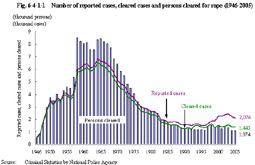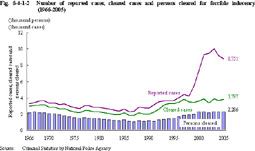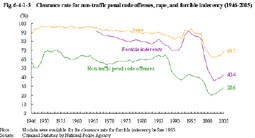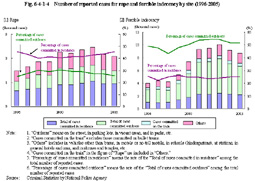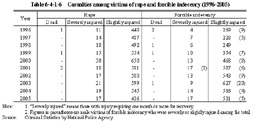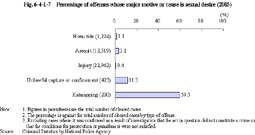| Previous Next Index Image Index Year Selection | |
|
|
1 Trends in sexual offenses (1) Numbers of reported cases, cleared cases, and persons cleared, and clearance rate
Fig. 6-4-1-1 shows trends in the numbers of reported cases, cleared cases and persons cleared for rape since 1946.
Fig. 6-4-1-1 Number of reported cases, cleared cases and persons cleared for rape (1946-2005) Fig. 6-4-1-2 shows trends in the numbers of reported cases, cleared cases and persons cleared for forcible indecency since 1966.Fig. 6-4-1-2 Number of reported cases, cleared cases and persons cleared for forcible indecency (1966-2005) Fig. 6-4-1-3 shows trends in the clearance rate for non-traffic penal code offenses, rape, and forcible indecency (for non-traffic penal code offenses and rape, since 1946, and for forcible indecency, since 1966).Fig. 6-4-1-3 Clearance rate for non-traffic penal code offenses, rape, and forcible indecency (1946-2005) (2) Sites of sexual offenses
Fig. 6-4-1-4 shows trends in the reported cases for rape and forcible indecency by site over the last 10 years.
Fig. 6-4-1-4 Number of reported cases for rape and forcible indecency by site (1996-2005) (3) Relationship between victims and suspects
Fig. 6-4-1-5 shows trends in the percent ratio of cleared cases for rape and forcible indecency by relationship between victims and suspects, over the last 10 years.
Fig. 6-4-1-5 Percent ratio of cleared cases for rape and forcible indecency by relationship between victims and suspects (1996-2005) (4) Casualties
Table 6-4-1-6 shows the casualties among victims of rape and forcible indecency over the last 10 years.
Table 6-4-1-6 Casualties among victims of rape and forcible indecency (1996-2005) (5) Offenses whose major motive or cause is sexual desire
Fig. 6-4-1-7 shows the percentage of cases of homicide, assault, injury, unlawful capture or confinement, and kidnapping whose major motive or cause was sexual desire.
Fig. 6-4-1-7 Percentage of offenses whose major motive or cause is sexual desire (2005) (6) Reality of sexual damages
With regard to sexual offenses such as rape and forcible indecency, there are hidden cases which victims do not report to the police (dark figure) behind the available number of reported cases. In the Second Crime Victimization Survey (dark figure) conducted by the Research and Training Institute of the Ministry of Justice in 2004, 27 out of 1,099 respondents (2.5%) said they had received sexual violence in the last five years (in the questionnaire, the question about sexual assault was as follows: "Males sometimes touch or assault females for sexual purposes. Such acts cannot be overlooked. Have you received any such sexual damage in the past five years, including domestic sexual assault?"). Among these 27 persons, only four (14.8%) answered that they had reported the damage to criminal investigation agencies.
|
